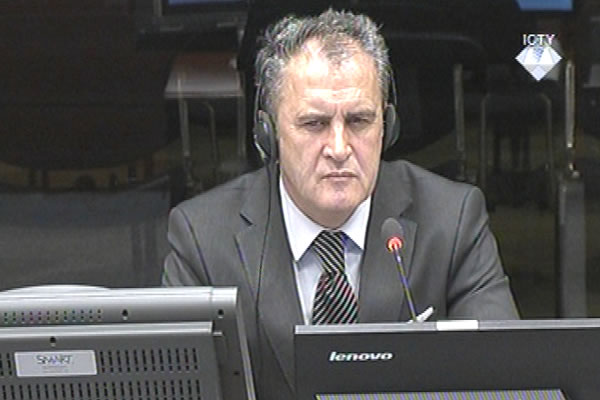Home
EVERYONE IS TO BLAME FOR SREBRENICA GENOCIDE EXCEPT MLADIC AND KARADZIC
According to the findings of Mladic’s defense military expert Mitar Kovac, everyone was responsible for the genocide in Srebrenica – Alija Izetbegovic, Bill Clinton, foreign intelligence services, Serb mercenaries and avengers, the Scorpions unit, and a part of the Bosnian Serb military services; everyone, in fact, but the Republika Srpska military and political leadership
 Mitar Kovac, defence witness at Rako Mladic trial
Mitar Kovac, defence witness at Rako Mladic trial Prosecutor Peter McCloskey, who has specialized for Srebrenica, took the final stage of Mitar Kovac’s cross-examination today. He focused on refuting the expert's finding that the accused was not in any way responsible for the mass executions of the captured Srebrenica men and boys in July1995. Mitar Kovac is Ratko Mladic's military expert.
In his report Kovac didn’t deny the crimes in Srebrenica. In Kovac’s view, the Bosnian Serb military and political leadership ‘did not plan’ them. ‘Most likely the crimes were planned with a view to preparing the international public through the media’ to tolerate the ethnic cleansing and killing of Serbs from Croatia and Bosnian Krajina in the second half of 1995. The crimes against people of Srebrenica were a ‘screen’ concealing the drive to continue the genocide against Serbs that had begun in the World War II.
Asked who else, apart from the Bosnian Serb leadership, could have planned the Srebrenica massacre, the witness replied that Alija Izetbegovic, the BH President, and the US President Bill Clinton had agreed to surrender Srebrenica to the Serbs. ‘Elements of the intelligence services in some parts of the international community’ exerted their influence. As to who committed the mass executions, Kovac said that ‘self-organized groups from Podrinje who were part of the criminal underworld before the war’ and ‘groups of vengeful Serbs’ were to blame.
The prosecutor turned his attention to Kovac's statement in his report that the perpetrators ‘likely worked hand in hand with some senior officers from the security services’. Asked to identify the officers involved in the crimes, Kovac named Drago Nikolic, Vujadin Popovic and Ljubisa Beara. The expert thus presented the chain of command in the security sector from the Zvornik Brigade to the Drina Corps and the Main Staff, where Beara was the security chief.
The three officers were indicted by the prosecution in another case, and the prosecution agrees that the security chain of command played a crucial role in the Srebrenica crimes, but it insists that it did not stop with Beara, but included Mladic too. Asked if Mladic was Beara's superior, the witness reluctantly confirmed that he was, but not directly. The chain involved Zdravko Tolimir, commander for intelligence and security in the Main Staff. Beara was not a rogue officer, the prosecution contends, as evidenced by a conversation intercepted on 23 October 1995, in which Mladic tells the Republika Srpska prime minister Dusan Kozic that the security chief in the Main Staff 'would never do anything I haven't ordered him to do'. All the officers named by Kovac have been convicted by the Tribunal and their convictions have been upheld on appeal. Drago Nikolic was sentenced to 35 years in prison, while Beara, Popovic and Tolimir all received life sentences. Mladic is still awaiting verdict.
As the prosecution noted, the role of the Bosnian Serb leadership could be seen in an excerpt from Directive 7 issued in March 1995, according to which 'an unbearable situation of total insecurity with no hope of further survival for the inhabitants of Srebrenica and Zepa' was to be created through “planned and well-thought out combat operations'. General Miletic from the VRS Main Staff drafted the Directive; Karadzic signed it and Mladic’s deputy, General Milovanovic, sent it to the units. According to the witness, there was an ‘error’ in the Directive. When it was discovered, the incriminating words were deleted from Mladic’s subsequent Directive 7.1. The prosecutor insisted that similar language was used at meetings in 1994 and 1995 attended by Mladic. At one of those meetings Mladic said, 'the enclaves are not here to survive but to disappear’. It was stated in Mladic’s presence that the enclaves should‘not survive’. These claims were made in the war diaries of Milenko Zivanovic, the then commander of the Drina Corps. The notebooks were shown for the first time today in the courtroom and were admitted into evidence. That does not happen often at this stage of the Tribunal’s existence.
According to Kovac’s findings, ‘mercenaries’, such as the Scorpions unit from Serbia, participated in the Srebrenica crimes. In Trnovo, the Scorpions executed six men and a boy and filmed the crime. A true Serb soldier would never film people being shot in the back, and document the crime in such a way, Kovac argued. The prosecutor then showed a Sarajevo-Romanija Corps document of 23 July 1995, in which the Scorpions were referred to as ‘our troops’. Also, a report drafted by the Republika Srpska MUP noted that the Scorpions, a unit of the Serbian MUP, held the defense lines near Trnovo. Asked if ten members of the Scorpions unit involved in the crime would have had to obtain permission from ranking military officers in Mladic’s army to leave their positions, Kovac replied that they wouldn’t have to do that. The unit was made up of professional killers and their intention was to sell the footage and ‘disgrace the national struggle’, Kovac explained.
Kovac completed his evidence today. Ratko Mladic’s trial continues on Monday.
Linked Reports
- Case : Mladic
- 2015-11-24 AKASHI'S 'THINKING OUT LOUD' ABOUT MLADIC
- 2015-11-23 'QUANTUM DIFFERENCE' IN CRIMES
- 2015-11-19 SARAJEVO CIVILIANS LACKED ‘SAFETY CULTURE’
- 2015-11-30 HISTORIAN CORRECTS GRAMMAR
- 2015-12-01 HOW WITNESSES IN VOJISLAV SESELJ’S CASE WERE MADE TO ‘CHANGE THEIR MINDS’
- 2015-12-01 DIFFICULTIES UNDERSTANDING CRIMINAL PROCEEDINGS
